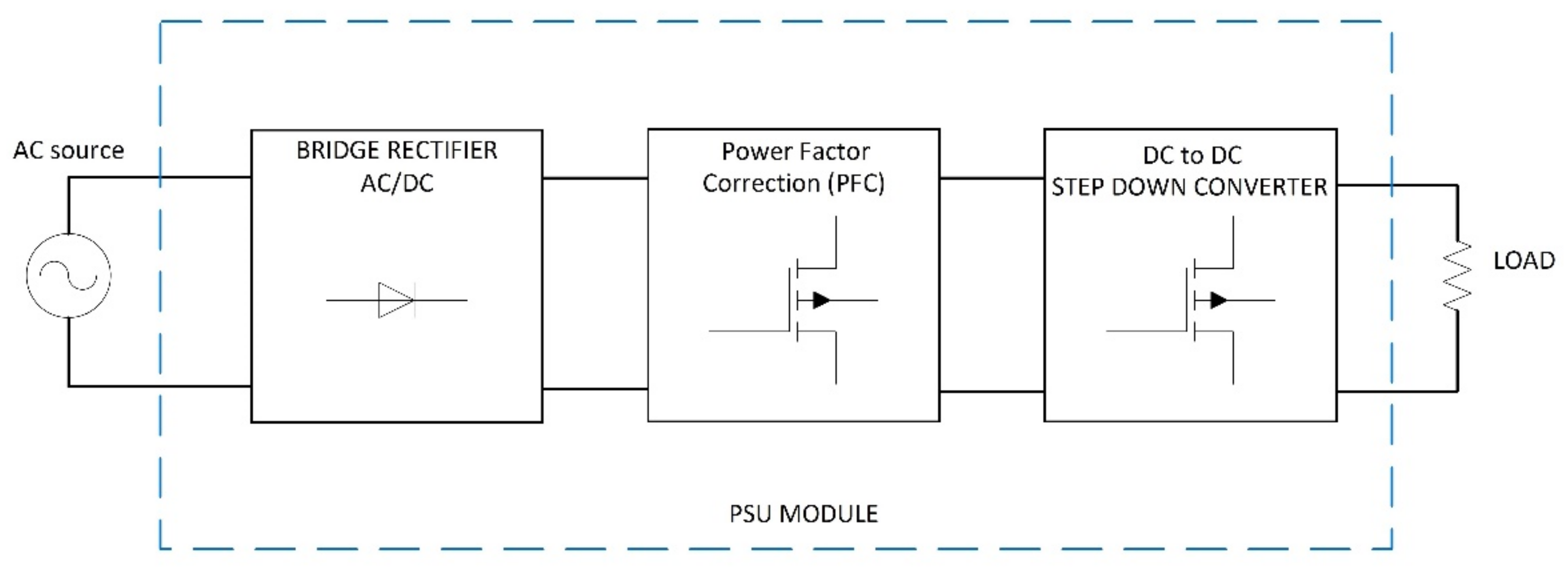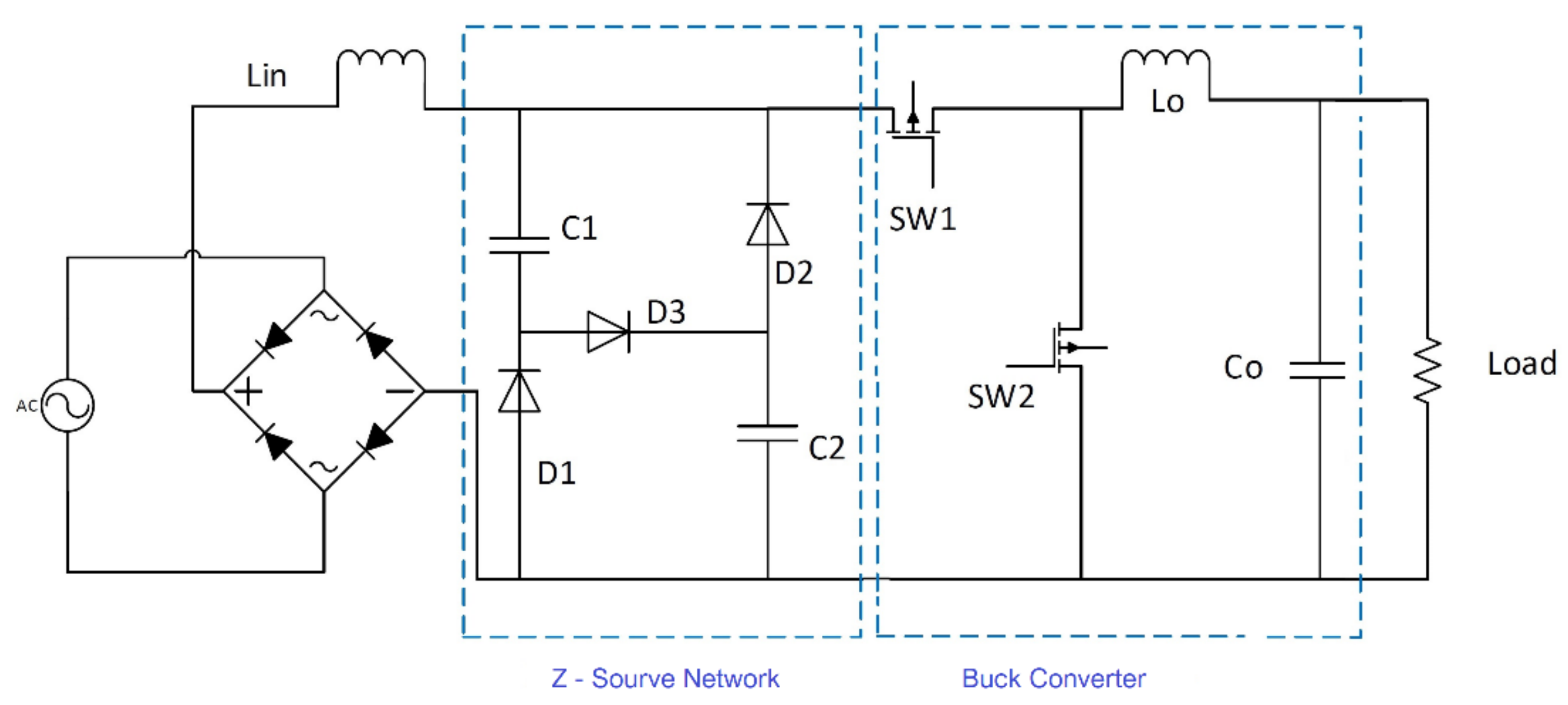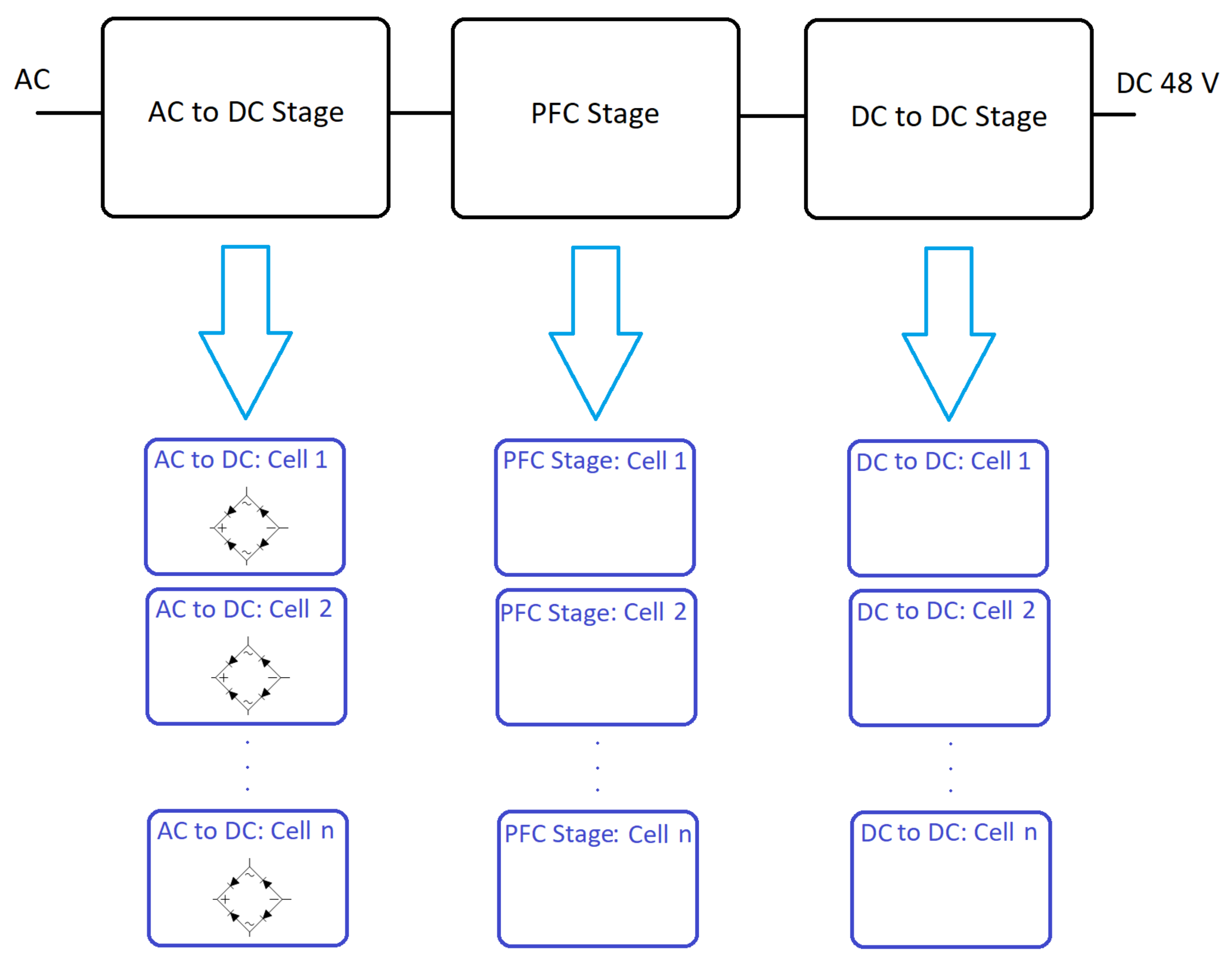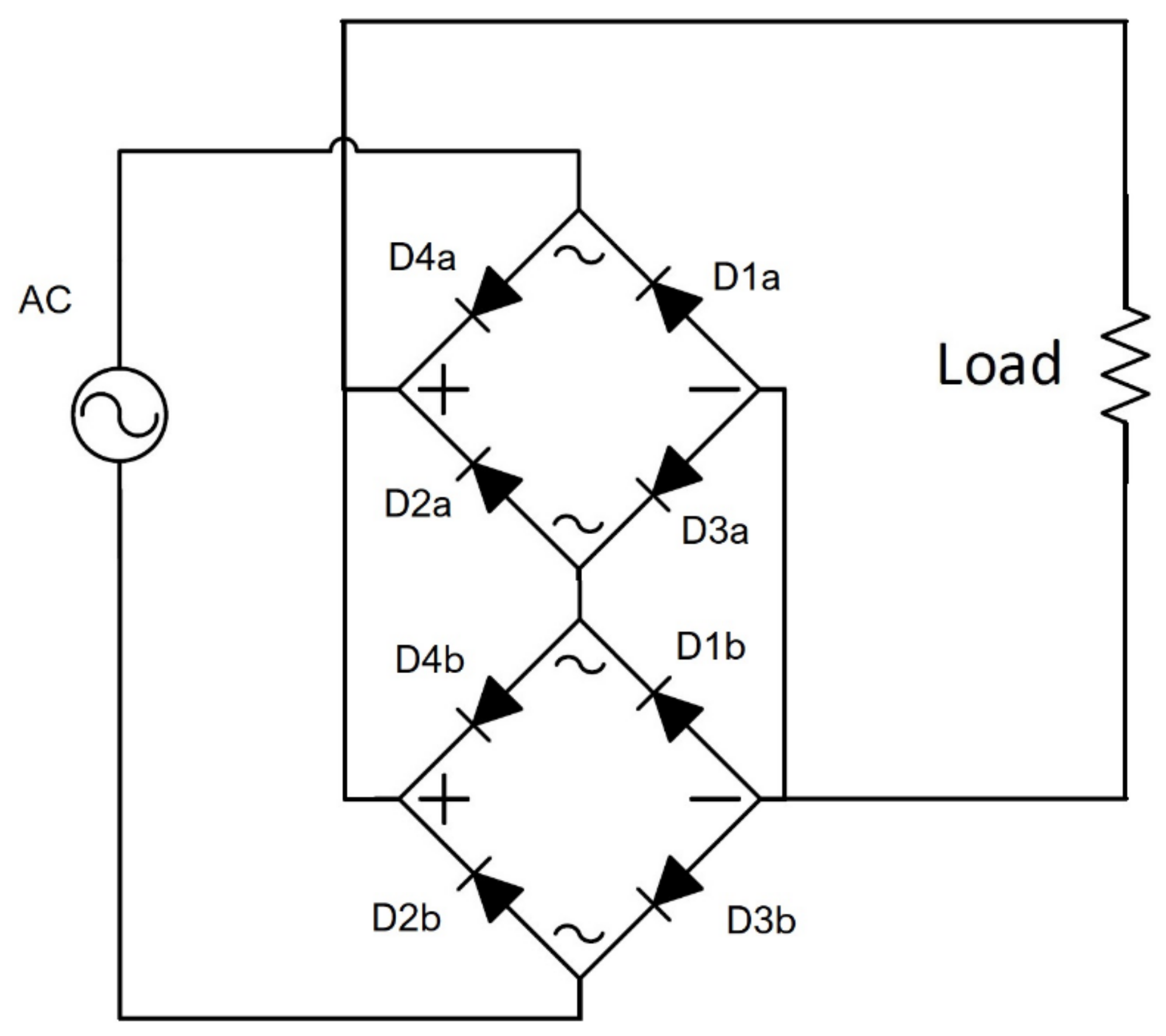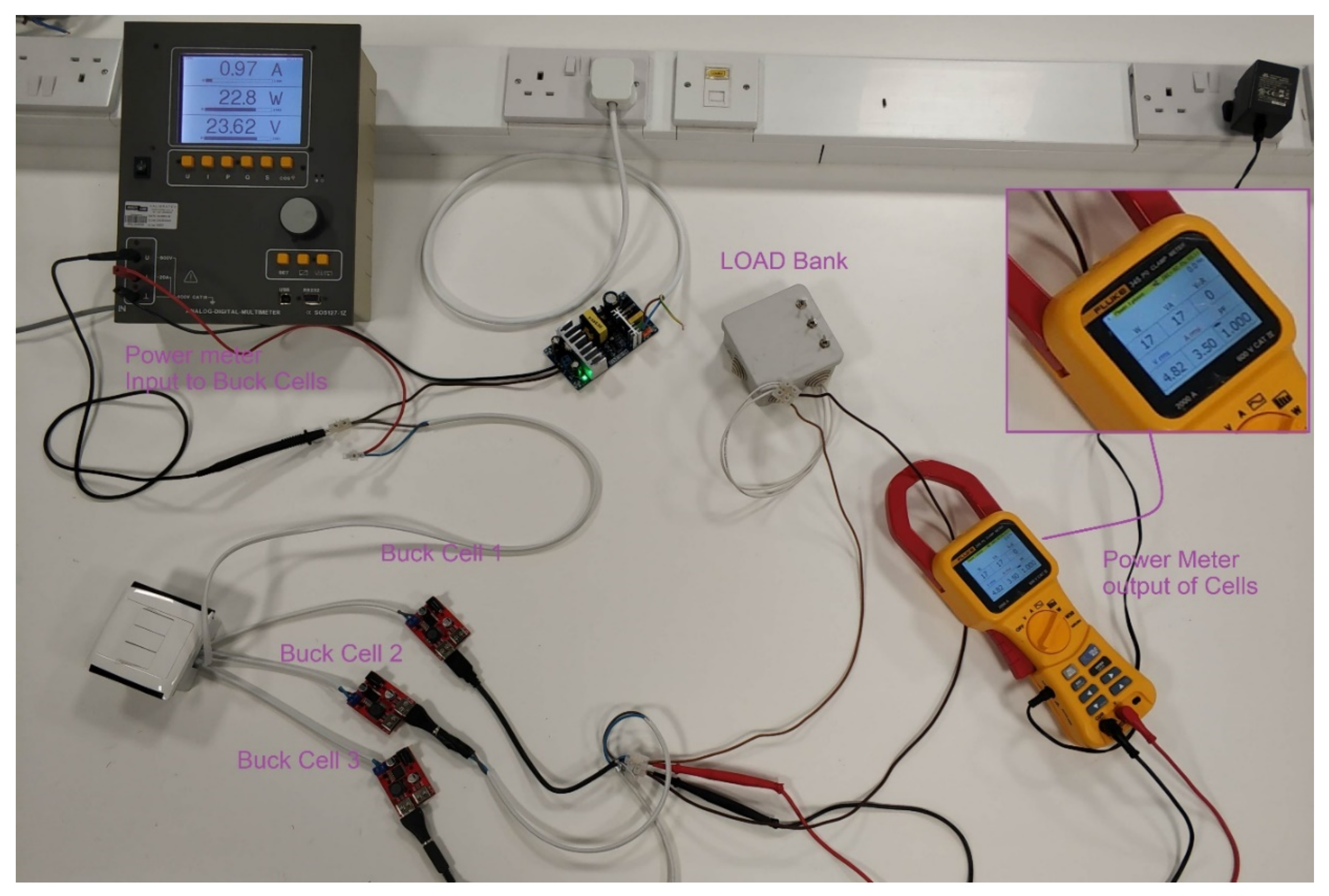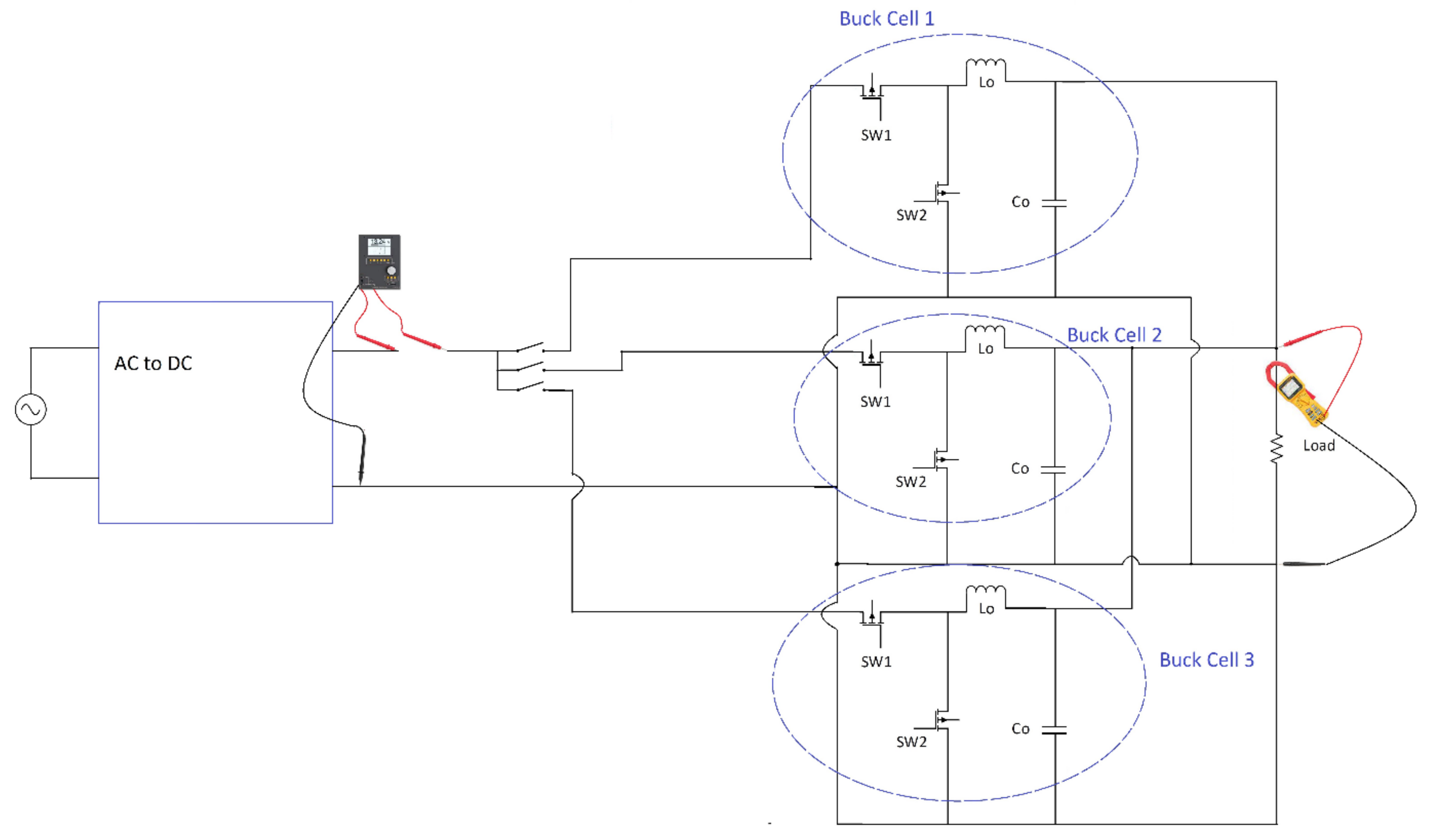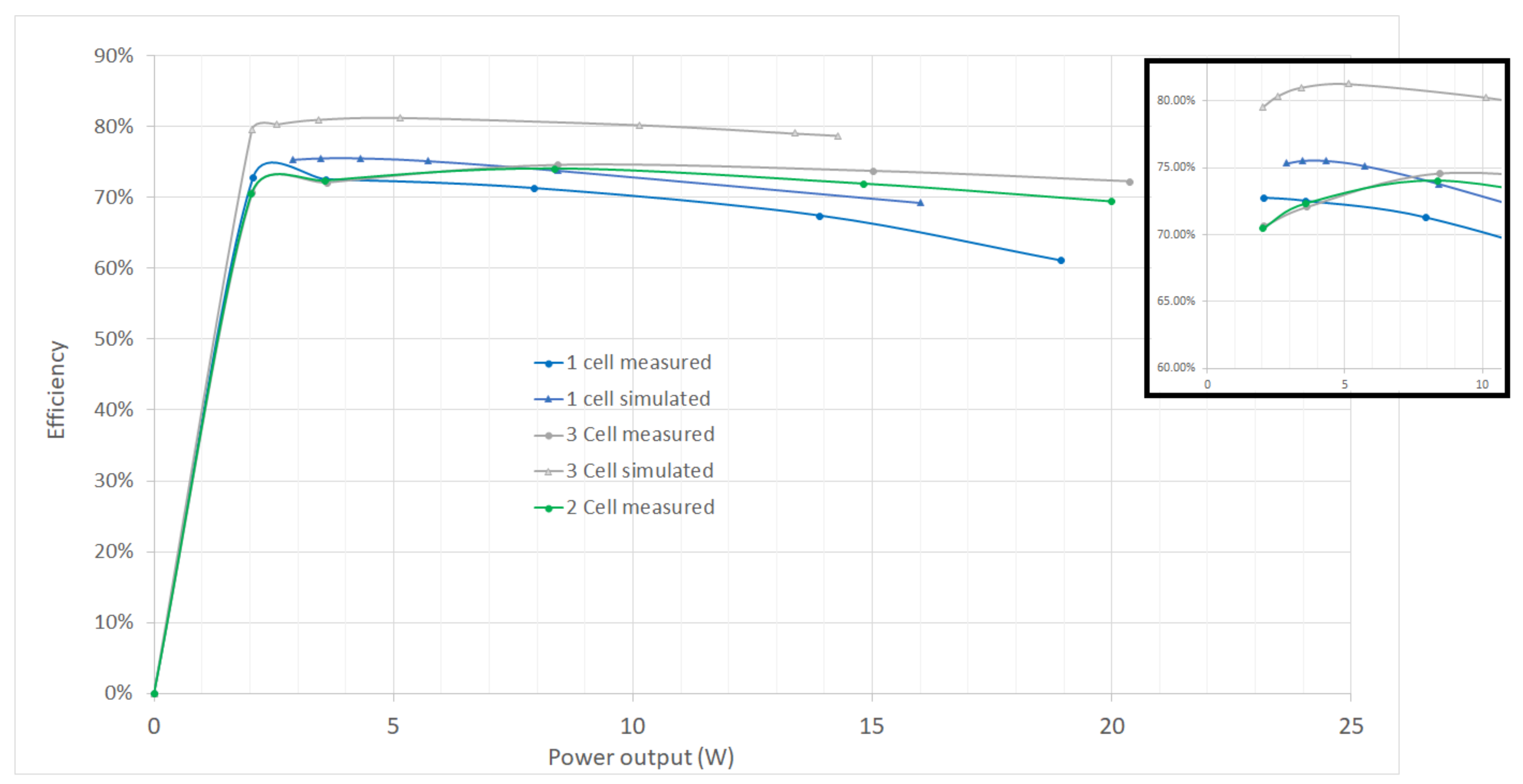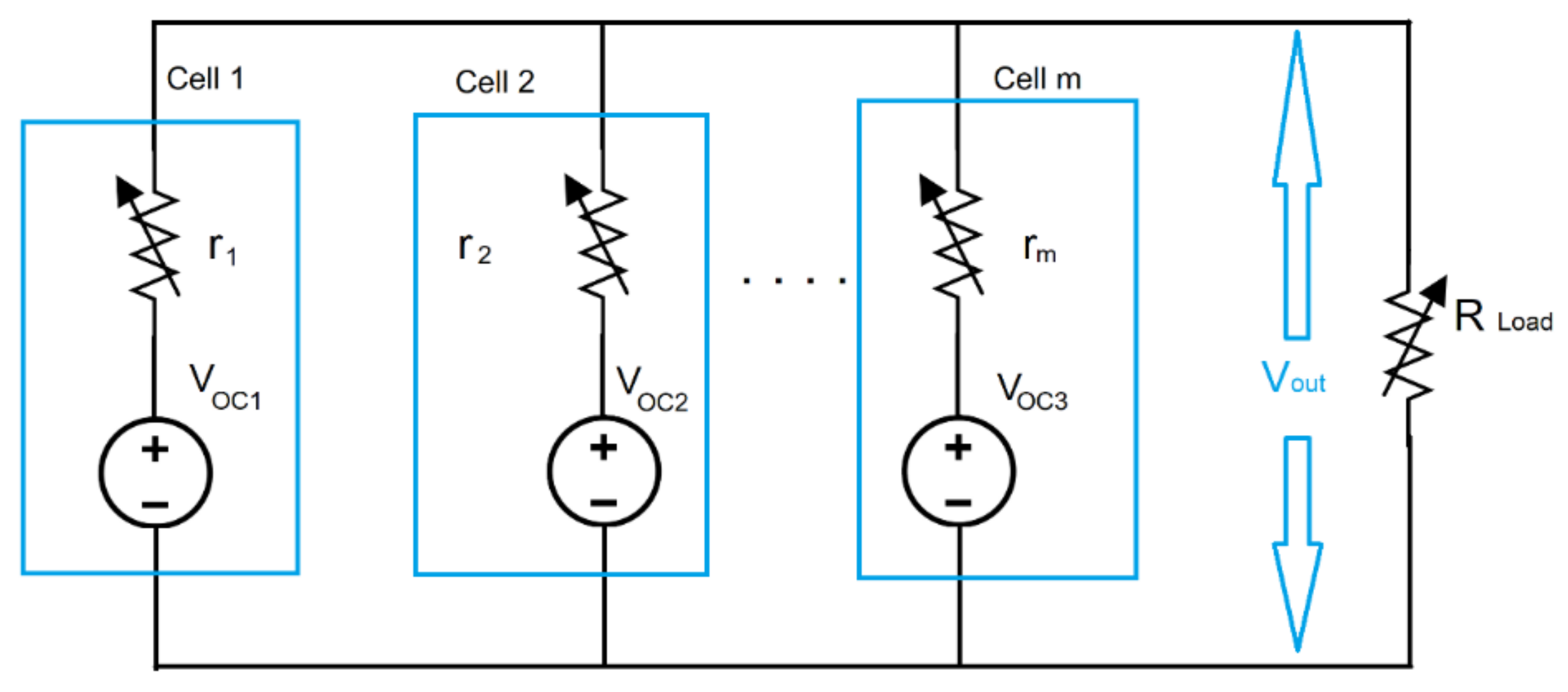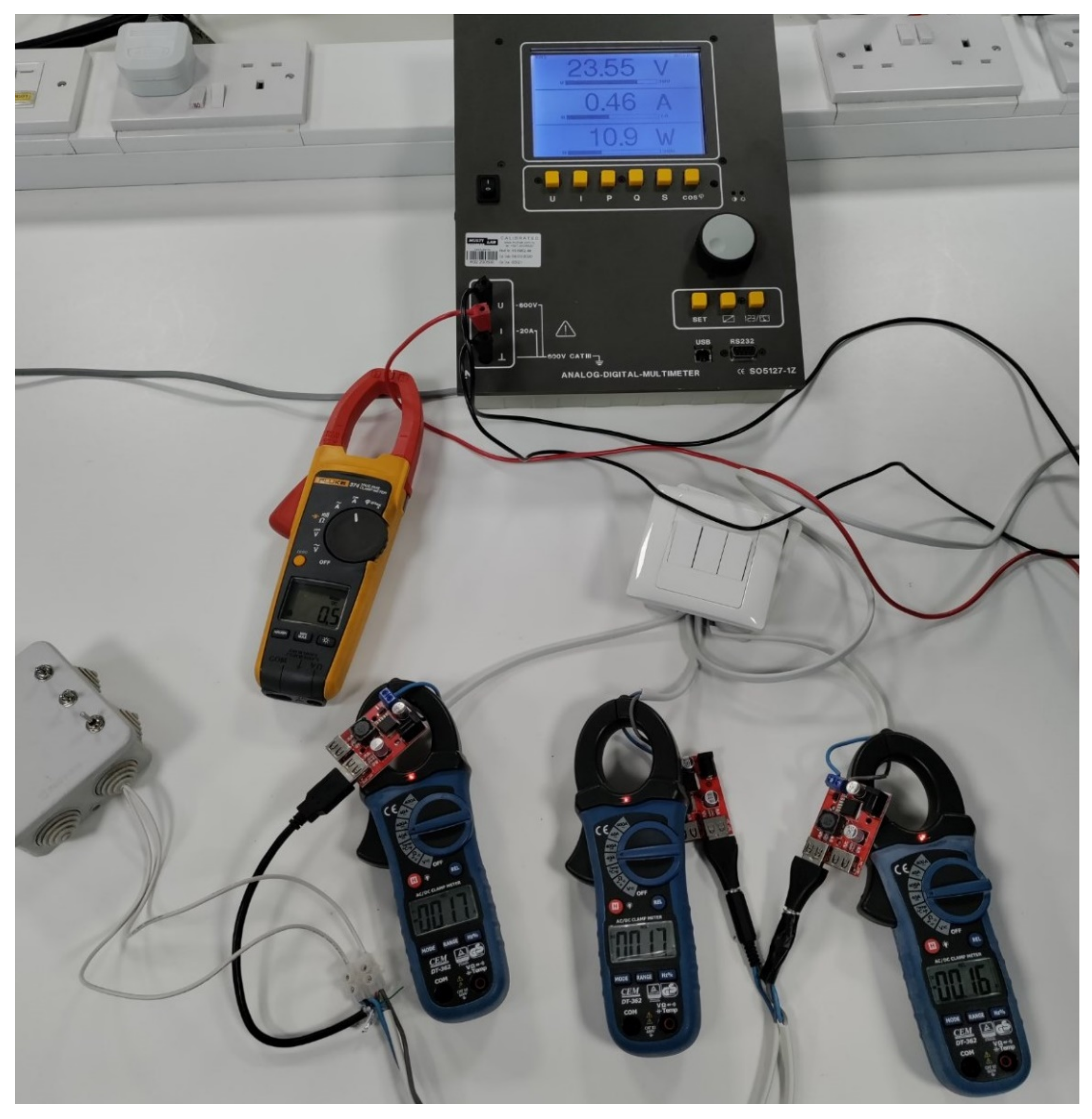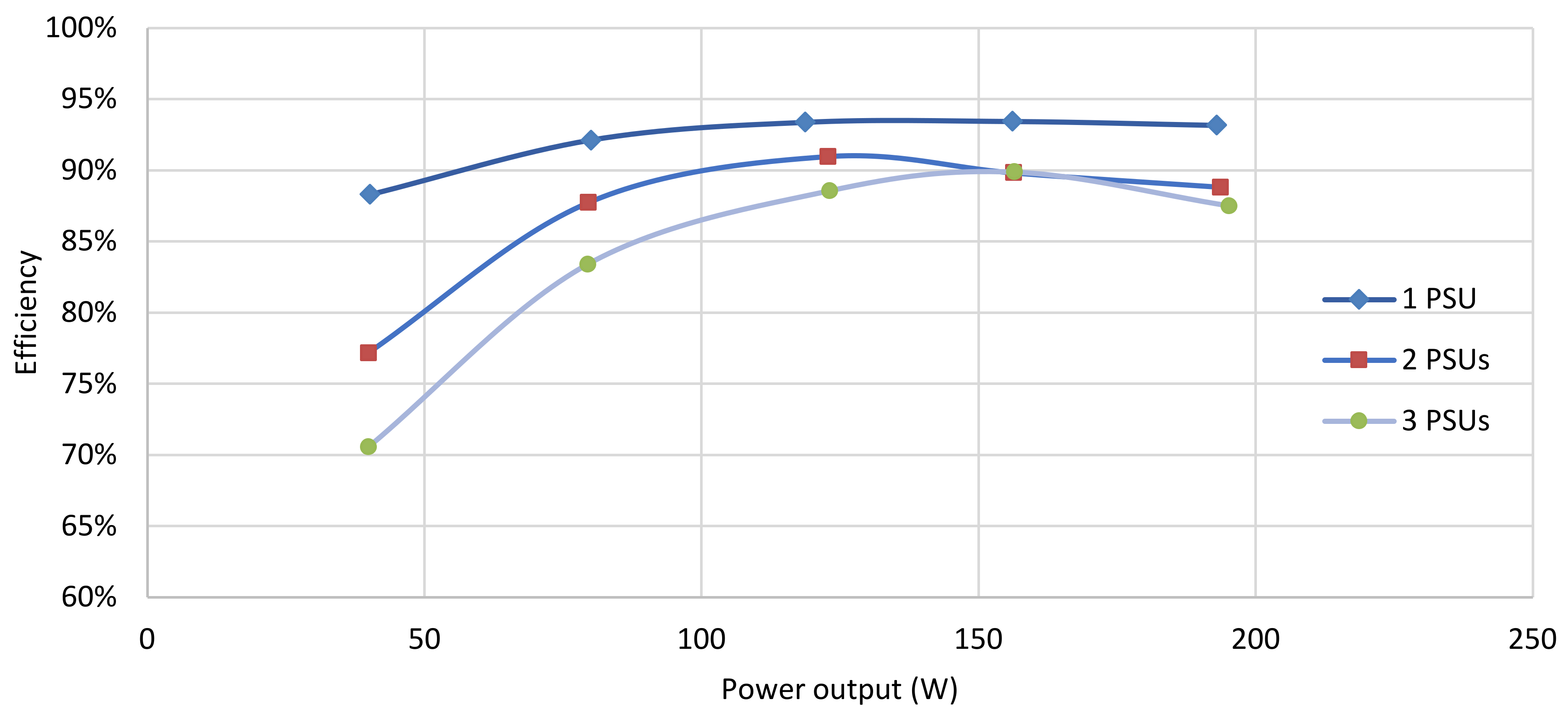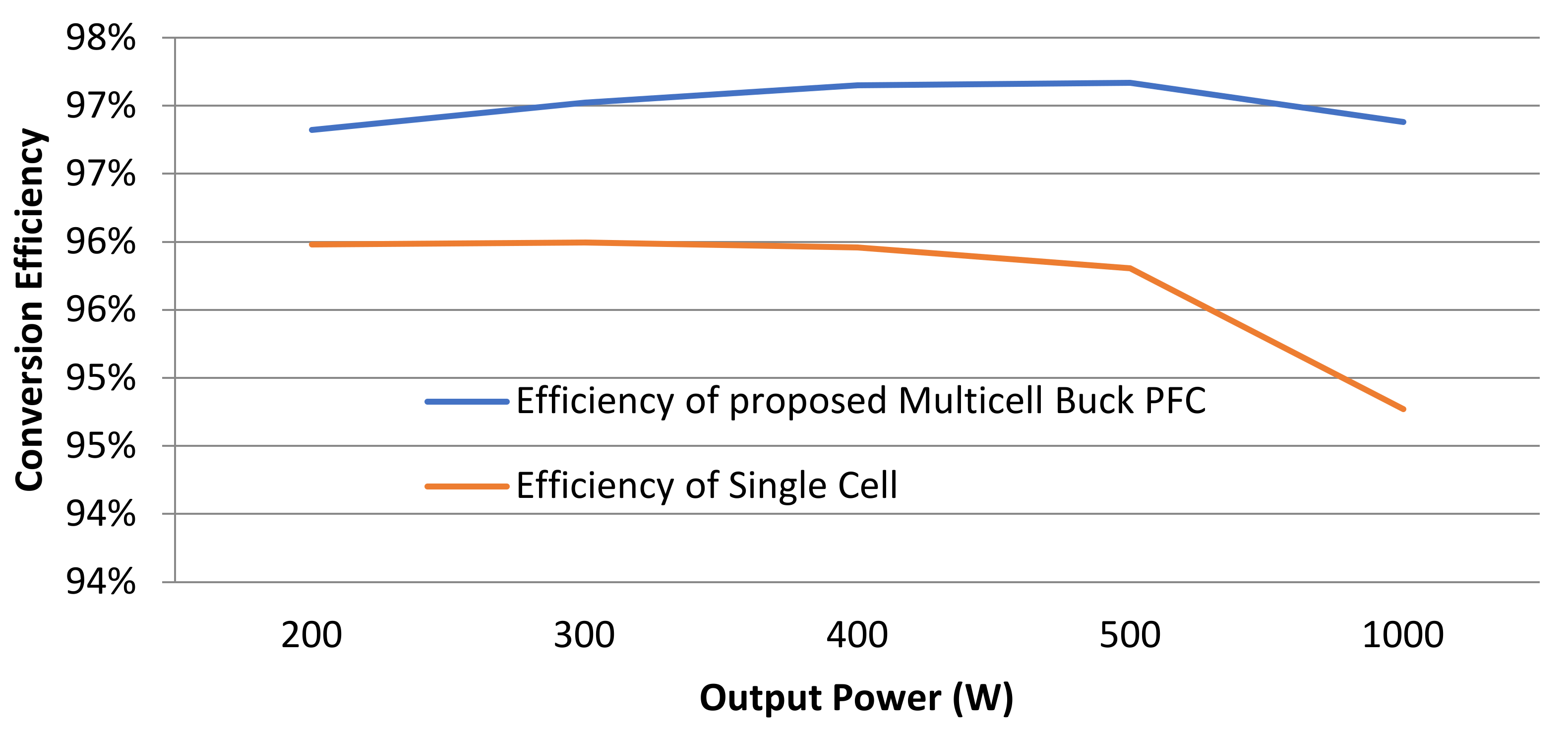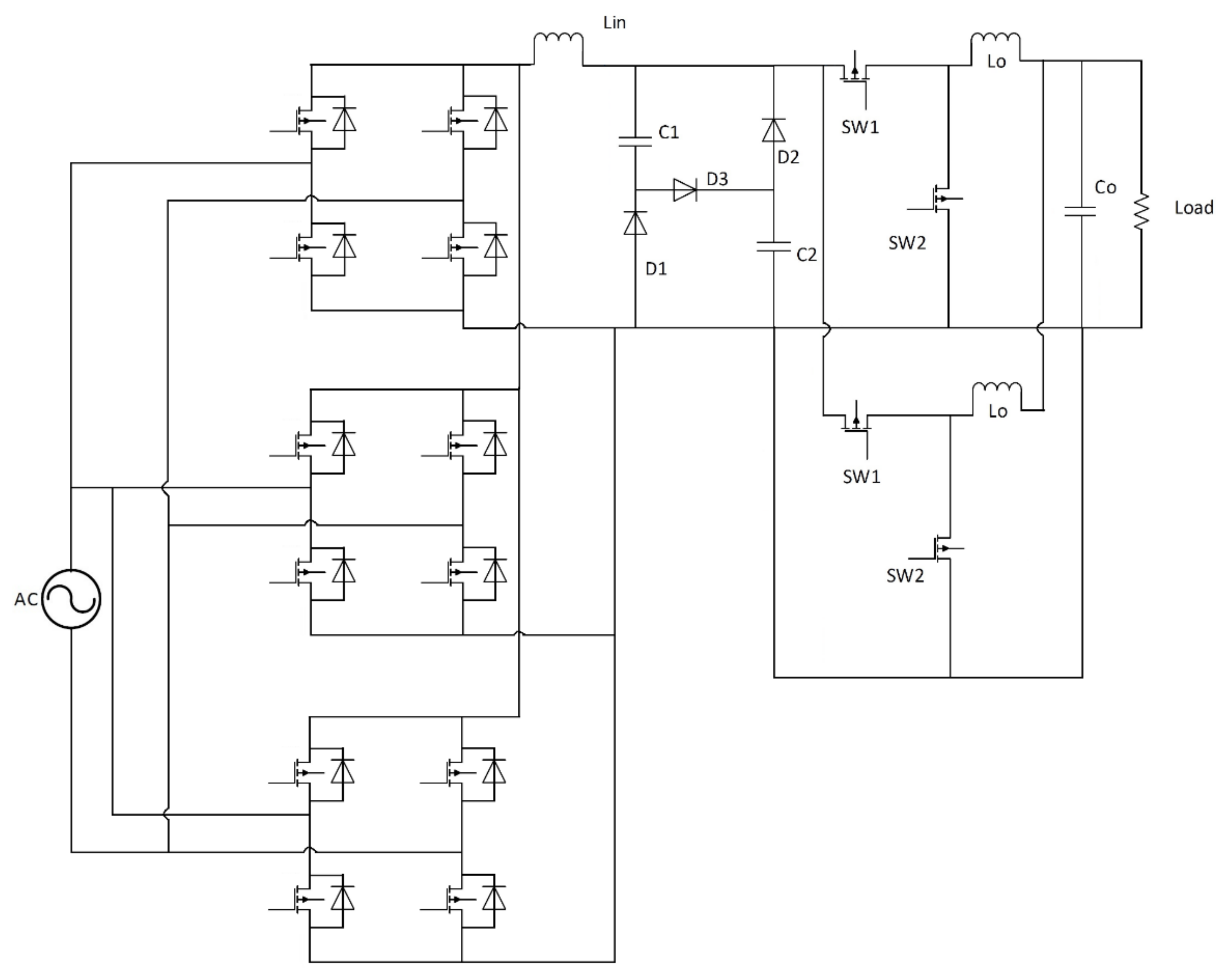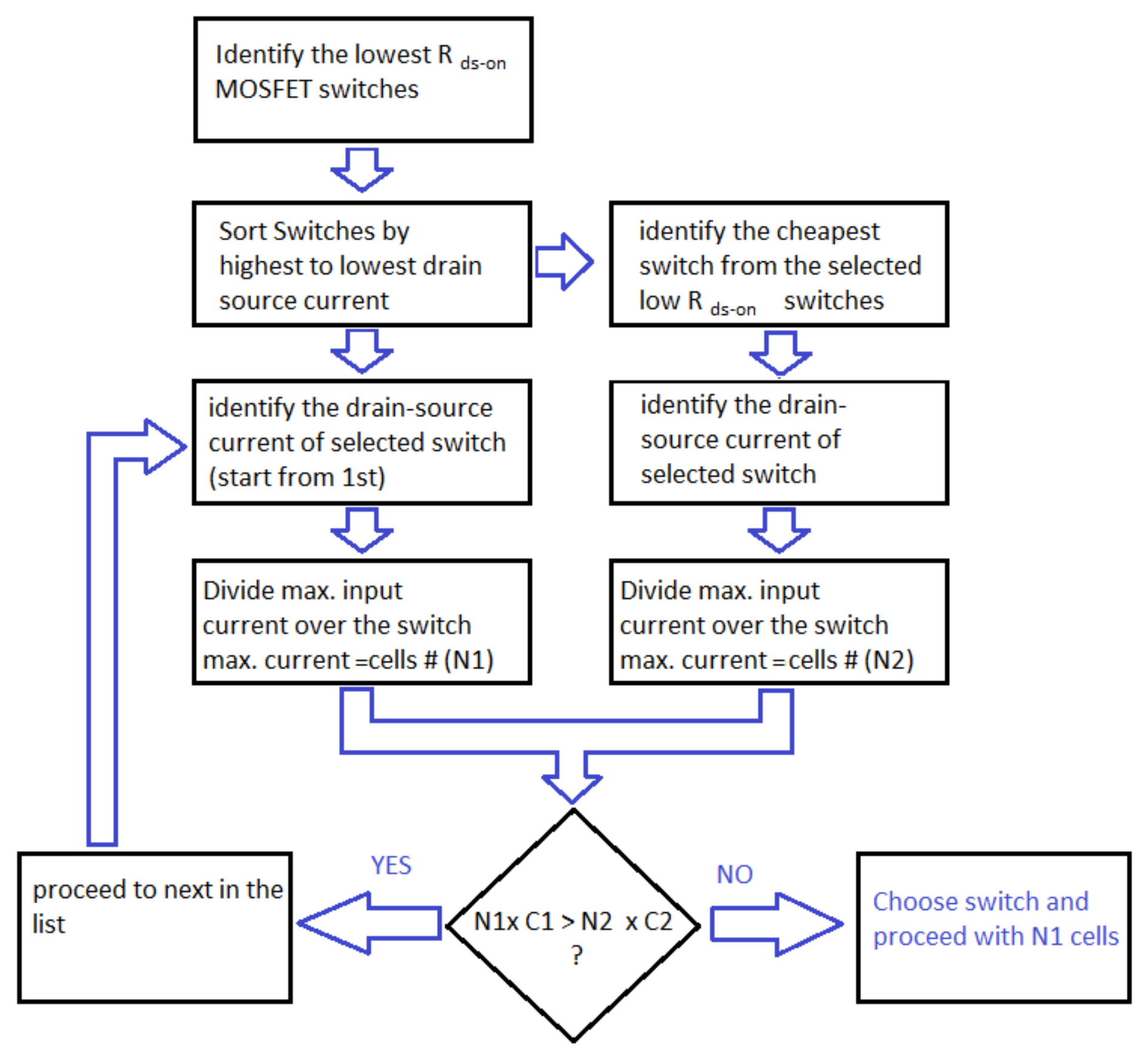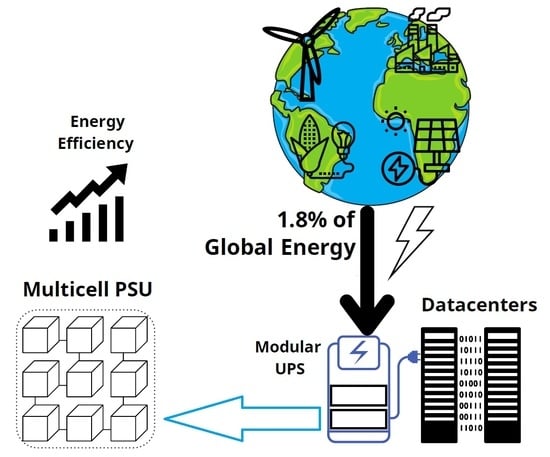1. Introduction
The 5G network requirements for the Information and Communication Technology (ICT) sector has caused a continuous demand for growth in micro-datacenter and Telecommunication Stations (TS) [
1,
2]. Datacenters accommodate the ICT data storage and processing equipment such as servers, hubs, hard discs, and ICT racks, etc. A micro-datacenter (μDC) is a datacenter of size smaller or equal to one rack. The growth of datacenters and micro-datacenters is huge nowadays and they have a great impact on global electricity consumption. In 2016, more than 1.8% of the global electrical energy was consumed by datacenters and this will keep increasing [
3]. The higher speeds of radio frequency bands (such as 4G and 5G) tend to have a shorter area coverage and as a result more TS are needed. Furthermore, 5G networks have increased energy requirements compared to previous generations, and therefore several researchers have concentrated on improving the energy efficiency of communication links [
4,
5,
6]. The increased number of TS and μDC will unavoidably lead to an increased energy consumption.
The impact of the power supply system to the overall energy efficiency of datacenters and TS has pushed several energy agencies to develop strict efficiency requirements, such as Energy Star and EPRI [
7,
8]. In the last two decades, the telecommunications industry has adopted equipment supplied by 48 V DC. In the Information Technology (IT) and Datacenter industries though, the preferred voltage system over the last few decades was 230 V AC, using though integral secondary power supplies for converting the AC 230 V to 12 V DC. With the IT and Telecom industry convergence of the last few years, both AC 230 V and DC 48 V systems were used, causing a debate as to which system would dominate the market. Over the last few years, Facebook initiated the “open compute project” (and other organizations have joined, such as Google and Microsoft), for promoting the 48 V DC distribution topology for the IT industry, because of its improved performance [
9,
10].
Multicell structures have been utilized in the last two decades for several applications, but the main objectives were the improvement of the voltage gain in the input or the output of a circuit and the component stress decrease. There are four different topologies of multicell structures which are:
Input in Series Output in Series (ISOS);
Input in Series Output in Parallel (ISOP);
Input in Parallel Output in Series (IPOS);
Input in Parallel Output in Parallel (IPOP).
Aiming for higher efficiency, Kasper et al. [
11] suggested a 6-cell converter system, which showed the highest efficiency conversion above 1 kW, however, the suggested converter [
11] has great efficiency only in specific loading conditions. Furthermore, the 6-Cell ISOP converter creates additional complexity to the system and reduced reliability, since failure of one of the cells could lead to overall system failure, especially as cells are connected in series at the input. Multicell structures have been used in various studies but not primarily for energy efficiency improvement. Arezki Fekik et al. [
12] proposes a three-cell DC to DC structure for Off-Grid PV systems for improved robustness using an ISOS structure but the study does not include an experimental verification and although simulation results are promising in terms of the maximum power point tracking (MPPT) function, the efficiency is not validated. Furthermore, the reliability of the three-cell DC to DC structure is reduced since failure of one of the three cells leads to overall system failure. ISOS structures in both AC to DC and DC to DC conversion stages do not significantly improve the efficiency and have much more complicated load sharing control [
13,
14]. The IPOS structure which is proposed in [
15] in order to improve efficiency and output voltage, reduces the overall system efficiency (maximum efficiency of 91%) and increases the complexity of the system.
The paper analyzes and compares multicell topology structures (ISOS, IPOS IPOP or ISOP) and the way that these can lead to energy efficiency improvements by investigating each stage of conversion (rectification, power factor correction and DC to DC stage through LLC and PSFB converters). The work verifies through simulations and experimental measurements that IPOP structures can lead to an improved energy efficiency conversion and proposes a new multicell buck PFC structure to increase the energy conversion efficiency. Furthermore, the work presents a technoeconomic evaluation of multicell structures compared to single structure power supply units.
The Introduction Section of the work is followed by
Section 2, which presents the structure of AC/DC 48 V power supplies. The section identifies and analyzes the three individual conversion stages and specifies single-stage and two-stage conversion alternative topologies. In
Section 3, the multicell structure topologies are introduced and analyzed. This analysis is subsequently followed by
Section 4, the experimental setup and verification. The proposed multicell buck PFC converter is presented in
Section 5 and a technoeconomic analysis follows in
Section 6. The last section of the paper,
Section 7, is the conclusion.
3. Multicell Structures
A multicell structure is a structure made of multiple converter systems (cells) which are put together and work in parallel or in series to form a new, larger converter system, as shown in
Figure 3.
This work aims to prove that combining multiple converters (multicells) in series or in parallel can lead to overall energy efficiency improvements. Since conversion from AC 230 to DC 48 V includes more than one conversion step, multicell efficiency improvements need to be analyzed per stage (AC to DC, PFC stage and DC to DC step-down stage).
3.1. The Multicell AC to DC Rectification Stage
A multicell rectification can be constructed either with diodes or switches (MOSFETs or IGBTs, etc.), as previously mentioned. A strategy to minimize the losses in the rectification stage is to use parallel diode bridge rectifier systems [
24]. Considering that each bridge circuit is a cell using multiple bridges, a multicell structure is formed. According to [
24], parallel diode bridge rectifiers lead to lower losses because diodes with lower maximum current carrying capacity have less forward voltage drop, although this stands only for specific applications. The power losses are mainly generated as a result of the conduction and the switching of the diodes or the switches. Due to the low switching frequency (50 Hz or 60 Hz), the switching losses are almost negligible and the resultant losses of each of the two bridge rectifier legs arise mainly due to conduction. The use of IGBT switches would not benefit such systems since IGBT losses are similar and higher than diodes for similar power applications. GaN MOSFETs tend to have lower switching losses than silicon MOSFETs despite their higher conduction resistance (on-resistance R
DS−On). For the diode case, the conduction losses are given by:
where
Vd is the diode voltage drop and
Irms is the average current passing through the bridge leg. For the MOSFET switch case, conduction losses are given by:
where
RDS−On is the on-resistance of the MOSFET switch.
Connecting bridge rectifier cells in ISOS or IPOS would imply that the output voltage is a multiple of 325 V (V
peak of AC input). This would require a very high gain to reduce it to 48 V and there would thus be higher power losses in the secondary circuits to step down the voltage. Additionally, a high voltage at the output of the bridge rectification stage would need switches that could withstand a higher voltage. Since R
DS−On is proportional to the voltage, this would result in higher power losses. Therefore, the multicell bridge would not have better efficiency if connected in ISOS or IPOS. The ISOP structure with MOSFET switches would not improve the efficiency either, since the series switches would increase the conduction losses. Considering however that the breaking voltage is proportional to R
DS−On, switches that can withstand a lower voltage would have lower conduction losses. Replacing, therefore, one MOSFET switch with two switches of smaller R
DS−On, could in theory result in better efficiency. Examining however the characteristics of available MOSFET switches, those with breaking voltage of 50 V have an R
DS−On as low as 3.3 mΩ (IFR3805), while switches with a breaking voltage of 200 V have an R
DS−On as low as 4 mΩ (IXFK300N20X 3). Therefore, energy efficiency improvement could not be achieved with ISOP and MOSFETs for this type of power supply. Analyzing the circuit further, it can be seen that the ISOP structure of the bridge rectification part would not provide any energy efficiency improvement with diodes either, since in each cycle of the AC source only two switches/diodes conduct, as seen in
Figure 4, as in the single cell structure, namely D
1a and D
2b in the positive cycle and D
3b and D
4a in the negative cycle. In the IPOP structure with diodes, the voltage drop increases as the number of cells increases. Efficiency is therefore slightly improved as a result of lower heat dissipation. For the case of the IPOP structure with MOSFETs, the voltage stress on the switches remains the same and the current passing through the system is divided in the parallel cell bridges, something that may lead to significant energy efficiency improvements.
For instance, in a two-cell rectifier bridge system, the current in the two legs is halved (assuming MOSFETs with the same R
DS−On) and since 2 (I/2)
2 < I
2, it can be easily proven that parallel bridge structures lead to overall energy savings. For N cells, it can be shown that:
3.2. The Multicell PFC Stage
There are different PFC structures. For single-stage converters, buck PFC can be used. For dual-stage converters, the boost PFC is widely used as well as some modified boost PFC circuits. All PFC circuits always follow the AC to DC rectification, or are incorporated into it.
3.2.1. Multicell Buck PFC
As discussed in the previous sections, to improve the power factor of the buck PFC circuits, the Z-source buck PFC circuit is proposed in [
14] by adding a Z-source network in front of the buck converter. As seen in
Figure 2, the circuit has two switches, SW1 and SW2. The losses arising in such a circuit are mainly as a result of conduction and switching, as well as due to the inductor at the input. Conduction losses are given by Equation (8) and the switching losses are given by Equation (9).
where
fsw is the switching frequency,
tr is the rising time the transistor needs to switch on and
tf is the falling time needed to switch off.
In a multicell parallel input configuration such as IPOP and IPOS, the input peak voltage would be 325 V DC (with ripple). For parallel cell circuits, the current in each of the parallel circuits would be split equally and the conduction losses would therefore decrease. The switching losses on the other hand cannot decrease. Considering the use of switches with a lower drain current, faster response, and thus lower tr and tf, they could potentially lead to better efficiency. However, using switches with lower tr and tf and at the same lower maximum drain current capability may negatively affect the RDS−On (i.e., conduction losses).
Connecting the multiple cells in series would require higher gain at the output. As a result, bigger inductor and capacitor at the output would be required, which would lead to higher losses, especially on low loads. Therefore, the IPOP is the only parallel input configuration that should be examined. In a parallel configuration, the inductor winding losses are also less since the current passing through them is divided by the number of cells and, despite the fact that core losses of inductors can increase, they are negligible compared to winding losses. The inductor size in the split cells would not be affected, since the output and input voltages as well as the switching frequency remain the same. The equation for calculating the inductor size is given by:
where Δ
IL is the ripple current and is proportional to the output current of each cell.
Connecting multiple buck PFC cells in series at the input (ISOP or ISOS) causes higher overall RDS−On resistance during the ON state. The switching losses, on the other hand, are multiplied by the number of cells but the voltage input is divided by the number of cells (assuming the case of exactly the same RDS−On). The rising and falling times of the switches in the multicell ISOP and ISOS structures can be minimized since switches with lower voltage breaking capacity tend to have lower falling and rising times. Silicon MOSFETs can have RDS−On as low as 3.5 mΩ, with rising and falling times of about 170 nS (IXFN300N20X3), while GaN MOSFETs can have 12.4 ns rising and 24 ns falling time with RDS−On of 25mΩ (GS66516). On the other hand, inductor losses increase if the inductor size is not reduced from the single cell design. Since voltage gain is reduced in the ISOP and ISOS structures, the inductor size can also be significantly reduced. Therefore, ISOP or ISOS structures lead to reduced inductor losses but with insignificant switching loss improvement. The overall improvements are minor in relation to the complexity and increase in cost.
3.2.2. Multicell Boost PFC
The losses in the boost PFC circuit (as in the buck PFC) are mainly due to switching and conduction loss of the MOSFETs, the input inductor and the output capacitor. However, because of the higher voltage stress applied on the switches of the boost PFC compared with that applied on the buck PFC, higher conduction losses occur. An ISOS and ISOP structured boost PFC would lead to increased losses in MOSFET devices since they would be connected in series, even if lower R
DS−On MOSFET switches are used. Since the inductors are in series in ISOP and ISOS structures, the overall DC resistance and hence inductor losses will increase. Considering the inductor size needed to form a multicell ISOP or ISOS structure compared to a single cell, it can be concluded that the ISOP case would lead to reduced losses compared to ISOS, but both cases would not lead to a significant reduction in the inductor’s overall size and power losses (6), (7) and (8). The single cell boost PFC inductor value is given by [
24]:
In a multicell ISOP boost PFC, the inductor value per cell is calculated by:
In a multicell ISOS boost PFC, the inductor value per cell is:
For IPOS and IPOP structures as in the buck PFC case, the current is split between cells and, as previously mentioned, reduces both inductor and MOSFET losses.
3.3. The Multicell DC to DC Voltage Step-Down in Two-Stage Conversions
The PSUs used in the ICT industry are converting AC 230 V to DC 48 V, and therefore high gain DC to DC step-down conversion stage is needed. The most common type of circuit for high efficiency DC to DC step-down conversion is the resonant converter such as LLC [
21,
22] and phase shift full bridge converters (PSFB). The presence of the transformer in these circuits provides magnetic isolation to the connected load. The losses for these types of converter circuits are again down to the switches, the inductors, the capacitors and the transformers. These circuits use zero-voltage switching (ZVS) techniques to minimize the switching losses. However, these techniques do not influence the conduction losses. The losses because of the inductors and the transformers are a result of the core and I
2 R of windings. The core losses are given by:
where
Ke and
Kh are the eddy and hysteresis loss constants,
Peddy is the eddy current power loss (W),
B is the flux density (Wb/m
2),
f is the frequency of magnetic reversals per second (Hz),
t is the core material thickness (m),
V is the volume of core (m
3) and
n is the Steinmetz exponent (ranging from 1.5 to 2.5 depending on the material).
Core losses are not proportional to the current passing through the coils. In inductors, the core losses are proven to be negligible compared to winding losses. In transformers, however, the larger the core size, the higher the core losses, even without any load. Paralleling transformers would reduce winding losses but would increase core losses and the overall losses would therefore also increase.
4. Experimental Verification of Multicell Structures
This experimental verification work validates the use of parallel converter cells within a PSU system for improved overall energy efficiency. To experimentally validate this proposal, a small-scale experimental setup was implemented with 3 buck conversion cells of a maximum power output of 18 W, input voltage of 24 V DC and output 5 V DC, connected in an IPOP structure.
Initially the setup was simulated in PSIM thermal module (version 12.0.3.) for comparison of theoretical and experimental results. The setup consists of 3 buck converter cells, a 3-pole switch for switching of the 3 parallel cells, variable loads, and two power meters measuring input and output voltage, and current and power. The buck cells used are commercially available and they employ the LM2596 controller. A photo of the experimental setup is shown in
Figure 5 and
Figure 6, showing the respective schematic diagram. The input power meter used is a Lucas-Nuelle analog/digital multimeter, which is the wattmeter and power-factor meter model SO5127-1Z, which has a measurement accuracy of 2%, and a capability to work with voltages of up to 600 V and a current range of 0–20 A. The meter used in the output of the multicell conversion system is a Fluke 345 PQ meter with an accuracy in current measurements of ±0.2 A or ±1.5% and an accuracy of voltage measurements of ±1%. It is worth mentioning here that since the measurements with 3 cells, 2 cells and 1 cell are comparative, the efficiency improvement could easily be verified. As it can be seen in
Figure 5, for 17 W load output, the power input with 3 buck cells is 22.8 W. For instance, at the same load (of 17 W) with 2 cells, the input power was 23.1 W. The voltage input to the 3 cells was 23.56 V and current input 0.97 A.
The efficiency of the single buck cell at different load conditions was measured, graphically analyzed and used as a baseline for energy efficiency. Following the experimental measurements with one buck converter cell, two and then subsequently three similar buck converter cells were used. Repeating the same methodology and measurement strategy, the load-efficiency curve was constructed, as seen in
Figure 7. It is worth mentioning that the no-load consumption of one, two and three PFC circuits have an effect on the load-efficiency curves. As it can be seen in
Figure 7, for loads corresponding to 10–20% of the full load (i.e., 1.8–3.6 W), the efficiency of one buck converter cell is higher than in the case with two and three buck converter cells. For instance, on 2 W load, the efficiency of 1 cell was 72.76% and with 3 cells it was 70.63%. Additionally, on 3.6 W load, the efficiency with 1 cell was 72.5%, with 2 cells 72.32% and with 3 cells 72.07%. This is due to the no-load losses of the PSU modules arising mainly from the inductors and the control circuitry. The no-load loss of a single buck converter cell is found to be 0.1904 W, that of two cells was equal to 0.238 W and for three cells 0.3094 W.
It can be theoretically and experimentally shown that when using parallel cells of the same converter type, size and brand, the load is equally shared between the number of parallel cells. Power converters or PSUs are voltage-controlled systems in which the controller must maintain the output voltage level within certain values for different loading conditions. Either in continuous conduction mode (CCM) or discontinuous conduction mode (DCM), the small signal model of the buck converter in the secondary (output) side of the converter consists of DC sources and a series impedance/resistance. The voltage and resistance of CCM and DCM modes is of course different when analyzing the small signal model. The equivalent simplified circuit for DC power supplies proposed from this work is shown in
Figure 8.
Using the circuit proposed, the equation of output power as a function of output voltage, load and internal resistance can be derived for different cells and is given by:
For cells which are multiple and dissimilar in size and type, it can be shown that connecting “w” number of cells of type A and “q” number of cells of type B in parallel supplying a common load, the voltage at the output is given by:
where:
Voc1 and
Voc2 are the cell type A and cell type B, open circuit voltage,
Vout is the output voltage of the system,
r1 is the internal resistance of type A buck-cell and
w &
q are the number of buck-cells of type A and B connected to the system, respectively. The power output of the system consisting of “w” cells of type A and “q” cells of type B is given by:
It is obvious from (12), (13), and (14), that each cell shares a portion of the output load based on the internal resistance, the open circuit voltage and the total load. For IPOP structures with the same type of converter cells, (in ideal conditions) it can be realized from equation (12) that the output power of each cell is equal. Measurements results for load sharing between cells are shown in
Table 1. The current was measured using three clamp-on ammeters, which were the brand and type CEM, DT-362. The input power is measured through a Lucas-Nuelle analog/digital multimeter called SO5127-1Z. The experimental set-up is shown in
Figure 9.
The no-load losses could not be measured by PSIM and this is why, in
Figure 7, the simulation results show higher efficiency in all load levels compared with the respective experimental ones. Under full load, an impressive 11.18% higher efficiency was measured with three cells compared to one cell. In addition to no-load losses, PSIM is unable to measure the capacitor losses, control system consumption and other losses arising from cabling or connections, etc. Most industrial power supply units require high frequency transformers for isolation purposes that generate, however excessive, no-load losses. A single centralized transformer should be used in PSUs adopting the multicell circuitry structure. If each cell uses its own transformer, this would result in increased losses and lower overall conversion efficiency. This can be proven experimentally by combining in parallel three complete PSUs, including their individual transformer, and measuring the efficiency for the different loads. Three Eltek Valere Micro pack 250 W, 230 V AC input/48 V DC output PSUs are used to perform this experiment. The input to the three PSUs was measured using a Lucas-Nuelle analog/digital multimeter measuring the input current, applied voltage and consumed power of the system. Each of the three PSU outputs was connected to “dummy loads” of different load values whilst measuring the output current and voltage. For every different load case, input and output parameters were measured so that the efficiency could be subsequently evaluated. The plot of efficiency versus load output is shown in
Figure 10, from which is it seen that the efficiency decreases as the number of PSUs connected in parallel increases. The no-load consumption of the PSUs (mainly as a result of the transformers) was measured and found to be 5 W per PSU (i.e., 2% of efficiency at full load).
6. Discussion
The results of the research have shown that parallel cells in multicell PSU structures can lead to significant overall energy efficiency improvements in PSUs. According to [
27], currently, 1.8% of global energy is supplied to the ICT industry, such as datacenters and micro-datacenters. More than 50% of this energy is supplied to the power supply units of the ICT equipment. Therefore, the impact of PSUs with improved energy efficiency could lead to significant energy savings in the ICT industry globally, and could contribute to the efforts and targets set for global energy decrease, through more efficient systems. Of course, the improvement in efficiency comes at an extra cost, as a result of the additional components used. The total manufacturing cost of a PSU system consists of the electronic components, the controller, the mounting, the enclosure, and labor costs. A PSU consisting of multicell parts would have an increased cost on components (cells) and labor costs but would not have an increased cost on the controller, the mounting and the enclosure systems. Additionally, as mentioned earlier, the transformer systems which lead to a significant cost in PSU systems should be single (centralized) and thus no additional cost should arise.
Analyzing the industry’s readymade PSU prices, it can be observed that when using smaller units (as in those in multicell structures) for a 20 kW PSU (1 full rack), the cost is slightly higher.
Table 4 compares the cost per watt using smaller PSUs for the same type and brand PSUs for different capacities.
The cost variation is in the order of 1–11%. For example, constructing a 20 kW power supply system with 20 pieces of RCP-1000-48 would cost 10.78% more than using 10 pieces of RCP-2000-48. Using 4 Mean Well RST-5000-48 instead of 2 RST-10000-48, would cost 0.8% more, but using Jetpower SP60-48/CR4830 instead of SPS200-48/SR4850 systems would cost less per installed Watt.
Finally, the proposed multicell IPOP structures have limited applicability for circuits that incorporate transformers. As stated in previous sections, transformers have no-load losses that do not favor decentralization (multicell structure). Centralization via the transformer part only of a multicell structure could overcome such limitations.
Further research will focus on multicell structures with planar transformers in matrix forms. Studies have shown that such transformers offer reduced no-load losses.
7. Conclusions
The results presented in this study demonstrate that using low-power modules such as the multicell structure for high-power PSU systems improves the energy efficiency. Using three rectifier cells and two buck PFC cells, a more efficient power supply system can be constructed for the same power output. Efficiency improvements of more than 1.2% can be achieved for 50% of the load and more than 2.1% efficiency improvement under full load. The concept of multicell efficiency improvement is experimentally proven through the testing of a three-cell, a two-cell and a single-cell buck converter system. It is shown that an efficiency improvement of up to 10% can be achieved for particular loads in the DC to DC conversion part. Energy efficiency improvements in PSUs leads directly to energy consumption minimization for the ICT industry.
The initial cost of a power supply system in a datacenter is about 5% of the total capital cost. A 10.78% increase in the power supply unit (i.e., the worst-case scenario) due to a multicell structure compared to a single cell one, corresponds to an additional 0.5% increase in relation to the total capital cost. The respective savings, however, are in the order of 2.1%, as previously mentioned. Looking ahead in the long-term, the cost benefit for this investment is viable, as with simple calculations the payback period is in the order of just 3.3 years.
